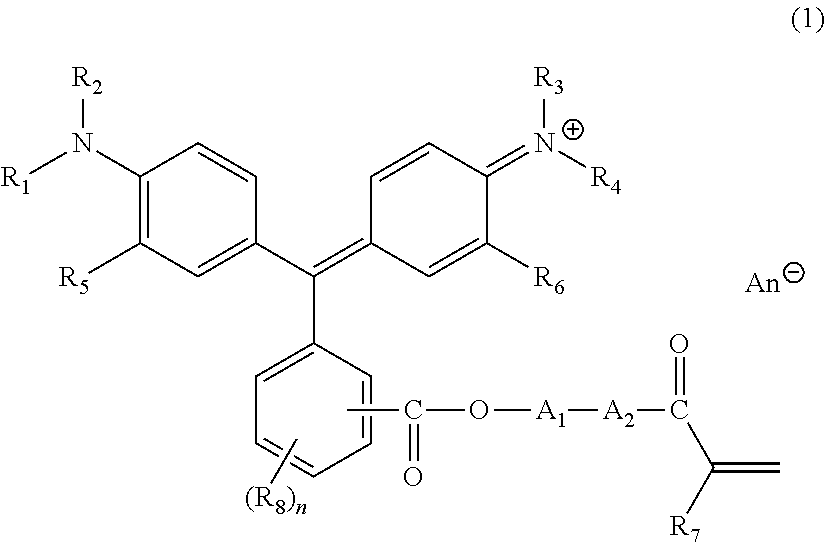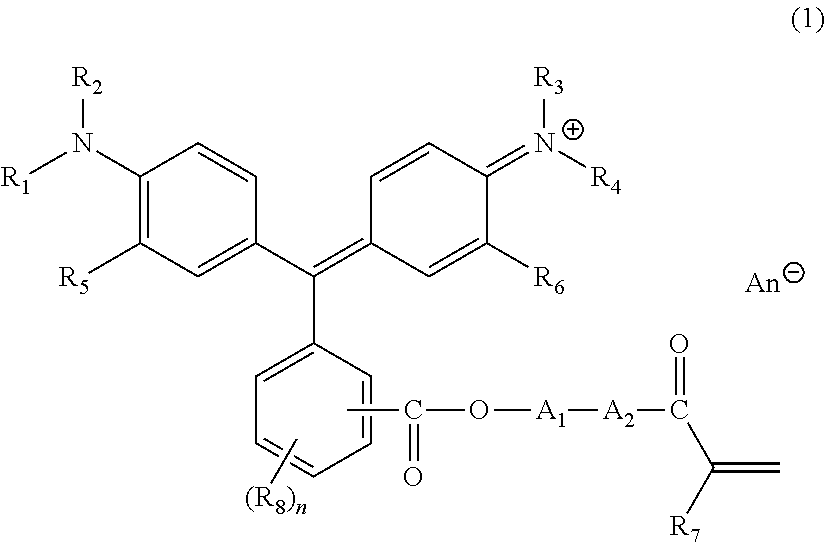Triphenylmethane-based colored composition
a technology of triphenylmethane and colored compound, which is applied in the direction of diaryl/triaryl methane dye, organic chemistry, inks, etc., can solve the problems of reduced heat resistance, limited micronization, and reduced contrast, and achieves superior heat resistance effect, less fading caused by heating, and high heat resistance
- Summary
- Abstract
- Description
- Claims
- Application Information
AI Technical Summary
Benefits of technology
Problems solved by technology
Method used
Image
Examples
example 1
Synthesis of a Dye Monomer 1
(1) Synthesis of a Triphenylmethane Derivative Having a Carboxyl Group (a Compound 3)
[0208]Into a round-bottom flask equipped with a stirring apparatus and a Dean-Stark apparatus, 5.0 g (33 mmol) of 4-formylbenzoic acid (a compound 1, produced by Wako Pure Chemical Industries, Ltd.), 16.1 g (133 mmol) of N,N-diethylaniline (a compound 2, produced by Wako Pure Chemical Industries, Ltd.), 60 ml of methyl isobutyl ketone (MIBK) (produced by Wako Pure Chemical Industries, Ltd.), and 6.3 g (33 mmol) of p-toluene sulfonic acid monohydrate (PTSA H2O) (produced by Wako Pure Chemical Industries, Ltd.) were added, and refluxed for 11 hours. Dichloromethane and water were added thereto for extraction, and then an organic layer was collected by washing with water. The solvent was removed by concentration under reduced pressure from the organic layer to obtain green oil. Dichloromethane and 1 mol / L hydrochloric acid were added thereto for extraction to obtain a water ...
example 2
Evaluation of Heat Resistance of the Dye Monomer 1 (230° C. for 0.5 Hour)
[0212]Heat resistance of the dye monomer 1 obtained in Example 1 was evaluated as follows.
(1) Synthesis of a Polymer not Containing a Dye.
[0213]Into a round-bottom flask equipped with a stirring apparatus, a cooling condenser, a thermometer and a nitrogen introducing unit, 98.5 g of propylene glycol monomethyl ether acetate was added, and heated until inner temperature reached to 90° C., under nitrogen gas flow. Next, a solution mixed with 186.2 g of benzyl methacrylate, 25.6 g of methacrylic acid, and 33.9 g of dimethyl 2,2′-azobis(2-methylpropionate) (a polymerization initiator V-601, produced by Wako Pure Chemical Industries, Ltd.) was dropped into heated propylene glycol monomethyl ether acetate taking 2 hours. After that, the resulting solution was reacted at 90° C. for 2 hours. Then, after raising temperature to 100° C., it was reacted for 1 hour. After the reaction, the solution was cooled down to room t...
example 3
[0220]Synthesis of a Dye Polymer 1 Containing a Monomer Unit Derived from the Compound 6
[0221]Into a round-bottom flask equipped with a stirring apparatus, a cooling condenser, a thermometer, and a nitrogen introducing unit, 25.6 g of propylene glycol monomethyl ether acetate (produced by Wako Pure Chemical Industries, Ltd.) was charged, and heated until inner temperature reached to 90° C., under nitrogen gas flow. Next, a solution mixed with 2.8 g of the dye monomer 1, 45.9 g of benzyl methacrylate (produced by Wako Pure Chemical Industries, Ltd.), 6.3 g of methacrylic acid (produced by Wako Pure Chemical Industries, Ltd.), and 8.8 g of dimethyl 2,2′-azobis(2-methylpropionate) (a polymerization initiator V-601, produced by Wako Pure Chemical Industries, Ltd.) was dropped into heated propylene glycol monomethyl ether acetate taking 2 hours. After that, the resulting solution was reacted at 90° C. for 2 hours, and further at 100° C. for 1 hour. After the reaction, the solution was co...
PUM
| Property | Measurement | Unit |
|---|---|---|
| heat resistance | aaaaa | aaaaa |
| brightness | aaaaa | aaaaa |
| heat resistance | aaaaa | aaaaa |
Abstract
Description
Claims
Application Information
 Login to View More
Login to View More - R&D
- Intellectual Property
- Life Sciences
- Materials
- Tech Scout
- Unparalleled Data Quality
- Higher Quality Content
- 60% Fewer Hallucinations
Browse by: Latest US Patents, China's latest patents, Technical Efficacy Thesaurus, Application Domain, Technology Topic, Popular Technical Reports.
© 2025 PatSnap. All rights reserved.Legal|Privacy policy|Modern Slavery Act Transparency Statement|Sitemap|About US| Contact US: help@patsnap.com



